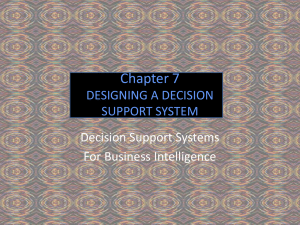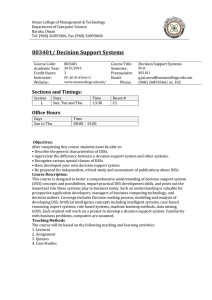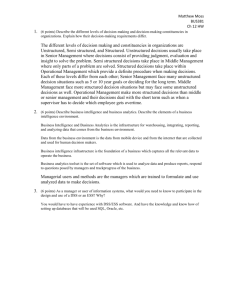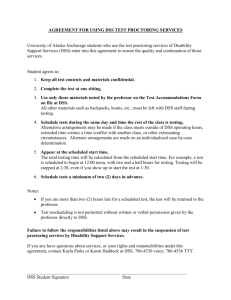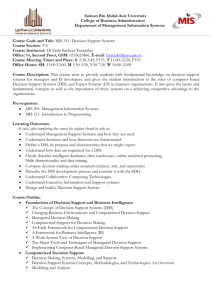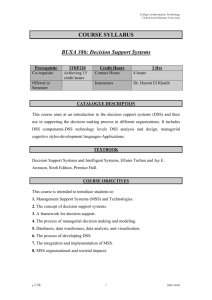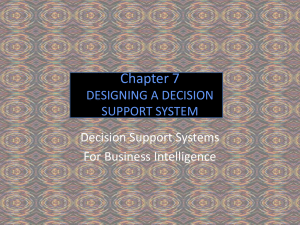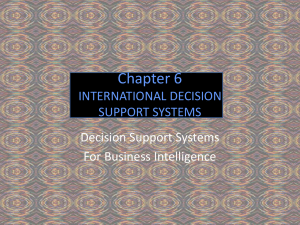PowerPoint Slides - University of Missouri
advertisement
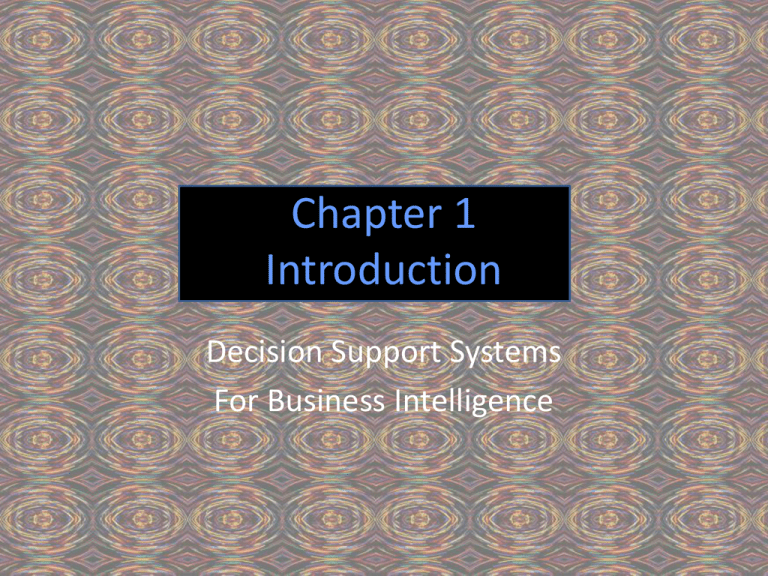
Chapter 1 Introduction Decision Support Systems For Business Intelligence DSS in Action Equifax provides DSS and supporting databases to many of America’s Fortune 1000 companies which allow these businesses to make more effective and profitable business decisions. The system allows users access to more than 60 national databases, mapping software, and analysis tools so that users can define and analyze its opportunities in a geographic area. The tool enables retailers, banks and other businesses to display trade areas and then to analyze demographic attributes. In particular, this DSS integrates customer information with current demographic and locational data. For example, Consumer-Facts (tm), offers information about spending patterns of more than 400 products and services in more than 15 major categories, with regional spending patterns incorporated. Further, it provides five-year projections that reflect the impact of dynamic economic and demographic conditions, such as income, employment, population and household changes, on consumer spending that can be integrated with a corporation’s own customer information. This coupling of data and analysis of reports, maps, and graphs, allow decision makers to consider questions of customer segmentation and targeting; market and site evaluation; business-to-business marketing; product distribution strategies; and mergers, acquisitions and competitive analysis. For example, the DSS facilitates consideration of crucial, yet difficult questions such as: • Who are my best customers and where are they located? • Which segments respond positively to my marketing campaign? • How will the addition of a new site impact my existing locations? • How can I analyze and define my market potential? • How can I estimate demand for my products and services accurately? • What impact will an acquisition have on my locations? • How is the competition impacting my business? Sauter, V.L. , Decision Support Systems for Business Intelligence, John Wiley, 2010 DSS in Action Biologists working at UM-St. Louis and the Missouri Botanical Gardens have used a specialized kind of DSS called a Geographic Information System to tests hypotheses in phytogeographic studies. The GIS allows for greater sophistication in studies of spatial components, such as the movement patterns of fruit-eating birds. For example, the Loiselle Lab at UM-St. Louis considered the Atlantic forests of Brazil and bird migration using a GIS. They modeled the historic distributions of birds in this region using a GIS and digitalized environmental layers from the National Atlas of Brazil. These historic distributions were compared to the present forest coverage to estimate the impact of the vast deforestation of this area. This allowed Loiselle and her colleagues to estimates the original habitat and the implications of its reduction. This, in turn, allowed them to consider a wide range of options that impacted biodiversity conservation decisions of these forests. Sauter, V.L. , Decision Support Systems for Business Intelligence, John Wiley, 2010 Design Insights Nobel laureate economist Herbert Simon points out: "What information consumes is rather obvious: it consumes the attention of its recipients. Hence a wealth of information creates a poverty of attention, and a need to allocate that attention efficiently among the overabundance of information sources that might consume it." (Scientific American, Sep 95, p.201) Hence, as the amount of information increases, so does the need for filtering processes which help decision makers find that which is most important and meaningful. Sauter, V.L. , Decision Support Systems for Business Intelligence, John Wiley, 2010 DSS in Action Today’s analytics provide more than just the profit level or sales quantity of a store. With new data mining tools managers can now get insights into why sales hit specific levels as well as what is likely to happen next month, thus giving them factors that can be manipulated to improve performance of shoppers. This, in turn, stimulates decisions such as how to rearrange store layouts , stock shelves and price items. Once shopping behaviors and preferences are understood, store then can tailor offerings accordingly to differentiate themselves from competitors. Britain’s Tesco relies on Mined data for most decisions, including the development of house brands. Kroeger (U.S.) uses mined data to profile customer buying behavior so they can better target coupons to make the store more appealing. The ability to predict customer response to changes in business rules provides a powerful competitive advantage for the store. Sauter, V.L. , Decision Support Systems for Business Intelligence, John Wiley, 2010 DSS in Action Jewish Hospital Healthcare Services uses various DSS applications in the areas of productivity, cost accounting, case mix and nurse staff scheduling. The systems include modeling, forecasting, planning, communications, database management systems and graphics. Furthermore, all of the data are drawn from key clinical and financial systems so there is not inconsistency in the data used by different decision makers. This allows decision makers to consider problems and opportunities from more dimensions, with better support than ever before. For example, the DSS includes a “nursing acuity system” for classifying patients by the severity and nursing-needs associated with their illnesses. These calculations can be used by the nurse staffing scheduling system to estimate the demand for nurses on a daily basis. Not only does this system help nurse managers to plan schedules, the DSS helps them to evaluate heuristics they might employ in developing the schedule. For example, they can compare the estimated nurse staffing needs to the actual levels to determine if there are better ways of managing their staffs. In this era of managed care, such analyses help the hospitals use scarce resources more effectively. Sauter, V.L. , Decision Support Systems for Business Intelligence, John Wiley, 2010 DSS in Action Hallmark, the 100 year old greeting card company, has used data mining to improve the effectiveness of direct marketing campaigns for its best customers. The company collects point-ofsales data, information about loyalty card holders and information obtained from the customers themselves to understand how and to what the customers respond. The analysis, which utilizes three years of data at the UPC (product) level for individual customers, provides profiles that help Hallmark understand what products to market and at what time to market to individual customers. Further, these analyses help Hallmark understand which of its marketing campaigns are successful (or not) and where increased marketing would bring additional revenues. Sauter, V.L. , Decision Support Systems for Business Intelligence, John Wiley, 2010 DSS in Action Data have begun to transform the management of professional sports. Managers who intelligently use data and analytics can improve asset acquisition and management, talent management, and operational performance. Billy Beane showed the world that his ideas about using analytics could produce a low cost baseball team that was competitive with those teams having a much higher payroll. Manager Billy, aided by assistant Paul DePodesta, first with the aid of a decision support system (AVM systems) and then on their own, broke down activities to predict a player’s ability to score runs and used that knowledge to decide how to build and manage the lowest cost, winning team in professional baseball. This effort was so amazing that when the Major League Players Association created the Commissioner’s Blue Ribbon Panel on Baseball Economics in 1999, they found Beane’s Oakland A’s to be an anomaly in their analysis. In fact, it was sufficiently troubling that the Commission asked Mr. Beane to appear to explain how he managed to be competitive. Some in baseball claimed he was just lucky. However, Mr. Beane knows that it is to the effective use of analytics in his organization. In fact, this use of analytical tools is chronicled in Michael Lewis’ best selling book, Moneyball: The Art of Winning an Unfair Game. Sauter, V.L. , Decision Support Systems for Business Intelligence, John Wiley, 2010 DSS in Action The Obama Presidential campaign of 2008 used a DSS that they called Neighbor to Neighbor. The campaign leveraged election board data with data collected on websites, rallies, or through telephone polls. The system included names and addresses of voters whom they believed were undecided in the campaign. It also included issues of interest to the specific voter, data about issues of interest in a particular region, and past voting records. Using this tool, staff members could more effectively identify scripts and pitches to use with particular voters to convince them to vote for Obama. In addition, they could customize fliers and other campaign materials to get their point to the voters more effectively. Near real-time data and sophisticated analytics helped volunteers use valuable campaign time more effectively. Sauter, V.L. , Decision Support Systems for Business Intelligence, John Wiley, 2010
